The Importance of Neurological Physical Therapy in Stroke Recovery
Stroke is a serious medical condition that can lead to a variety of physical and cognitive disabilities. A stroke occurs when a blood vessel in the brain is blocked or ruptured, resulting in a lack of oxygen to the brain. Fortunately, with proper treatment, many stroke survivors are able to make a full recovery. One important aspect of stroke recovery is neurological physical therapy, which can help to improve physical and cognitive function.
Neurological physical remedy is a type of therapy that uses physical movement to help improve the function of the nervous system. This type of therapy can be used to help improve symptoms of neurological conditions, such as stroke, cerebral palsy, and Parkinson’s disease.

Image Source: Google
What Is Neurological Physical Therapy?
Neurological physical therapy is a specialized form of physical therapy that is designed to help improve physical and cognitive function in people who have suffered a stroke. It focuses on improving strength, coordination, balance, and mobility, as well as addressing any cognitive impairments.
Neurological physical therapy can help to treat a variety of conditions related to strokes, such as weakness, paralysis, balance and coordination problems, difficulty walking, and cognitive impairments.
How Does Neurological Physical Therapy Work?
Neurological physical therapy works by helping to improve physical and cognitive function. It may involve a combination of exercises, stretches, and activities to help strengthen the muscles, improve coordination and balance, and address any cognitive impairments.
During a neurological physical therapy appointment, the therapist will take a detailed history and examine the affected area. They will then create a customized treatment plan to help improve physical and cognitive function. This may include a combination of exercises, stretches, and activities.

